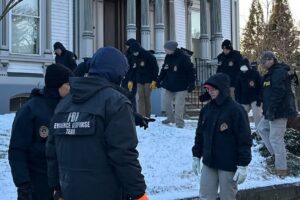
US investigators examining the January midair collision of a passenger plane and an army helicopter over Washington that killed 67 people found the chopper was flying higher than the it should have been and the altitude readings were inaccurate.
The details came out of the first day of National Transportation Safety Board (NTSB) hearings in Washington, where investigators aim to uncover insights into what caused the crash between the American Airlines plane from Wichita, Kansas, and the Black Hawk helicopter over Ronald Reagan National Airport.
The board opened the three days of hearings by showing an animation and playing audio and video from the night of the collision, as well as questioning witnesses and investigators about how the Federal Aviation Administration and the Army may have contributed to the nation’s deadliest plane crash since November 2001.
Family members of the victims of American Airlines flight 5342 who perished in a collision with a U.S. military helicopter, react while watching a video of the moment of the crash, during the NTSB fact-finding hearing on the DCA midair collision accident, at the National Transportation and Safety Board boardroom, Wednesday, July 30, 2025, in Washington. (AP)
It’s likely too early for the board to identify what caused the crash.
The January incident was the first in a string of crashes and near misses this year that have alarmed officials and the travelling public, despite statistics that still show flying remains the safest form of transport.
Animation, altimeter discrepancy
The hearing opened on Wednesday with a video animation showing where the helicopter and airliner were leading up to the collision.
It showed how the helicopter flew above the 61 metres altitude limit on the helicopter route along the Potomac River before colliding with the plane.
Investigators said the flight data recorder showed the helicopter was actually 24 metres to 30 metres higher than the barometric altimeter the pilots relied upon showed they were flying.
So the NTSB conducted tests on three other helicopters from the same unit in a flight over the same area and found similar discrepancies in their altimeters.
Dan Cooper, of Sikorsky helicopters, said that when the Black Hawk helicopter involved in the crash was designed in the 1970s, it used a style of altimeter that was common at the time.
Newer helicopters have air data computers that didn’t exist back then that help provide more accurate altitude readings.
The January collision between the passenger plane and the Blackhawk helicopter in Washington DC was captured by CCTB. (Nine)
Chief Warrant Officer Kylene Lewis told the board that she wouldn’t find a 24 metre to 30 metre discrepancy between the different altimeters on a helicopter alarming because at lower altitudes she would be relying more on the radar altimeter than the barometric altimeter.
Below 152 metres, Lewis said she would be checking both instruments and cross referencing them.
She said as long as an altimeter registers an altitude within 20 metres of the published altitude before takeoff the altimeter is considered accurate under the checklists.
But previously, NTSB Chairwoman Jennifer Homendy highlighted that the published helicopter routes around Washington DC would allow planes and helicopters to routinely come within 22 metres of each other during landing.
Army officials said on Wednesday that the flight manual for these older Black Hawks doesn’t highlight the discrepancies in altimeters that has been documented previously, but typical flight separations are at least 150 metres around airports.
Previously disclosed air traffic control audio had the helicopter pilot telling the controller twice that they saw the plane and would avoid it.
The animation ended with surveillance video showing the helicopter colliding with the plane in a fiery crash.
A piece of wreckage is lifted from the water onto a salvage vessel, near the site in the Potomac River of a mid-air collision between an American Airlines jet and a Black Hawk helicopter, at Ronald Reagan Washington National Airport. (AP)
Investigations have already shown the FAA failed to recognise a troubling history of 85 near misses around Reagan airport in the years before the collision, and that the Army’s helicopters routinely flew around the nation’s capitol with a key piece of locating equipment, known as ADS-B Out, turned off.
Aviation lawyer Bob Clifford, who is working to file one of the first lawsuits against the government next month, said he hopes NTSB will look beyond the immediate factors that caused this crash to highlight the bigger ongoing concerns in the crowded Washington airspace.
Homendy said the hearings over the next few days will be a “fact-finding proceeding”.
The NTSB will also post thousands of pages of evidence from the crash investigation online.





